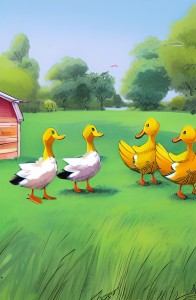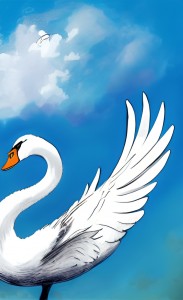History of creation
The tale “The Ugly Duckling” was written in 1843 by Andersen and published in the collection New Tales. Literary scholars believe that the tale is autobiographical. The ugly duckling is young Andersen, who had an extravagant appearance: he was thin and clumsy, so that many aroused pity and a desire to help. Three trials of the ugly duckling are associated with the three stages of Andersen’s life. In Odense’s hometown, his mother sent him to a Jewish school for poor children, where there were no corporal punishment, but the boy there felt like a stranger. Aviary – allegory of Copenhagen. There, the young ugly Andersen caused only ridicule, because he wanted to become an actor. He experienced the same ridicule in the prestigious schools of Slagels and Elsinore, where he was arranged at government expense by well-wishers. After all, Andersen was 6 years older than classmates, that is, big and awkward, like an ugly duckling. He was very upset by the rector’s attacks, just as the ugly duckling was afraid of a warlike Native American rooster in the poultry yard.
Andersen’s biographers associate the life of a duckling in a hut with an old woman, a cat and a chicken with the relations of the young man with the family of his patron, financier under King Frederick 6 Jonas Collin.
When analyzing a fairy tale it is wrong to rely on the bibliographic method. Although there are similarities with the writer’s biography, such an interpretation of the tale is primitive. The tale does not boil down to the claim that Andersen became a great storyteller, although no one expected it.
Literary direction and genre
The tale “The Ugly Duckling” is written according to the laws of a romantic direction. The hero is lonely and opposed to the whole world, is not understood by anyone and does not even understand his value. The beauty of the white swans seems to the ugly duckling distant and unattainable. But at the end of the tale, the Ugly Duckling does not turn into a lone white swan, but connects with brothers and is accepted by them. Of course, swans are not accepted by the poultry yard (that is, the romantic hero is not understood by the inhabitants), but they do not need it. But people see the beauty of swans and recognize it. They play in the fairy tale the role of the ancient gods, who suddenly noticed the beauty and noted it, announced the truth that the inhabitants would accept.
The ugly duckling genre is an author’s tale. But it is more like not a fairy tale about animals, but a philosophical parable. All the heroes of the tale are allegories, but if in the fairy tale about animals the hero is an allegory of quality (fox – cunning, hare – cowardice), then in “The Ugly Duckling” the heroes represent a certain human type, a certain fate.
Subject, main idea and problems
The theme of the tale is the acquisition of the meaning of life and its place in society. The main idea is that the truth will still be revealed. The ugly duckling will inevitably turn into a white swan if he avoids many dangers on his life’s journey. There is no ugliness in the world. Happiness and acceptance are the normal state of living things.
The problems of the tale are social and philosophical. Andersen with irony and even sarcasm depicts a society of townsfolk, philistines who are unable to see beyond his nose and jump above his head. At the same time, the philosophical thought of the fairy tale is deep: it is better to die, fulfilling its purpose in its place, than to endure hardship, living according to the meager laws of the townsfolk, providing not a bright life, but a miserable existence.
The plot and composition
The tale begins with a summer landscape and with an exclamation sentence: “It was good outside the city!” This is the author’s point of view. Emotionally, the ending echoes the beginning of the tale: “Could I dream of such happiness …” This is the thought of an ugly duckling, who came in harmony with the whole world.
On the way to this harmony, the ugly duckling undergoes many trials. His birthplace is a thicket of burdock. As befits a romantic hero, the ugly duckling brings troubles to the immediate environment even before birth, because its egg is ugly large, and it takes longer to incubate. A mother reconciles a duck with an ugly son only because he is not a turkey, because he swims beautifully.
The first test of the duckling takes place in the poultry yard. This is “socialization”: ducklings comprehend the laws of society. And these laws are crazy from the point of view of the narrator: two families fight for the acne head that goes to the cat, the duck with the red shred on the foot is the most important, and you need to pay the same acne heads. Andersen devalues power and money, showing their worthlessness.
The ugly duckling is attacked because it is “big and strange.” He is rejected by society, relatives, even his mother. So the duckling is in the swamp.
The third test is strangers. They no longer laugh at the duckling; they do not care about him. The only concern of wild ducks is that the duckling does not intermarry with them. And the wild geese are even ready to accept the duckling in their company: “You are such a freak that we like us.”
The fourth test of the duckling is a danger not to self-esteem, but to life. Even the enemy (dog) does not attack the duckling, it is so ugly. Here the duckling learns to enjoy his position, he thanks God for his ugliness. There is a final humility with his rejected position.
The fifth test is no longer connected with the appearance, but with the activity of the duckling. Finding himself in a hut with a half-blind old woman, a chicken and a cat, the duckling became convinced of his worthlessness. He does not know how to do two useful things: to lay eggs like a chicken, or to arch his back and purr like a cat. An old woman is an image of blind fate that does not see that a duckling by its nature cannot bear eggs. And the fact that duckling (the ability to swim) is inherent in nature is called by the chicken dope and whim. The duckling does not pass the probationary period of “smart people”, “the best half of the whole world” and leaves.
The next stage in the development of a duckling is a meeting with its ideal – royal birds. The duckling does not associate itself with them. The winter that he experiences thanks to the peasant who warmed him up is the last misfortune of the duckling. His happiness is preceded by a crucial decision: it is better to be killed by swans than to bear the enmity of ducks, chickens, poultry houses and winter cold.
Humility always precedes exaltation.
Seeing the reflection in the water, the swan duckling was able to accept the truth and become happy. Having accepted himself, he turned out to be accepted by both swans and people who recognized him as the most beautiful.
Heroes and images
The first characteristic is given to the gray duckling by the mother: “It is terribly large and completely unlike the others.” If you think about it, greatness and individuality from birth are inherent in this son, only the duck does not know how to appreciate it.
Of course, the self-characteristics of the ugly duckling are related to the attitude of the mother: ugly, a laughing stock for the whole bird’s yard.
For the time being, the mother duck protects her child, because she finds positive qualities in him: “He is ugly, but he has a kind heart, and he swims … better than others.” In addition, the mother hopes that “he will grow up and will push his way.”
But relatives quickly get tired of the unusual duckling: the brothers and sisters want a cat to eat him, and his mother curses him: “My eyes would not see you!”
All require the duckling to conform to his own ideas about correctness and decency. Chicken and cat allow duckling to make a choice, but only between laying eggs and arching their backs.
The duckling is an exile; he does not meet either the internal or external requirements of society, so when he sees swans and loves them, he does not envy them and does not dream of being like them. Family and society have achieved their goal: the duckling has lost his dream and goal.
As a truly romantic hero, he decides to approach his ideal even at the cost of life. But, having decided, he finds himself, a society of like-minded people, love and happiness.
Artistic originality
The images of the tale are allegorical and ironic. The irony is manifested in dialogues and author’s assessments. This is a mockery of the society of philistines-inhabitants, which can be read only between the lines. The subtext allows criticizing society. For example, a duck is proud of ducklings because they look like a father. They should be clubfoot, “keep the legs apart and turn them out” only because dad and mom did it. That is, the shortcomings of the parents are repeated in children, and this is considered the norm.
Common truths come from the lips of birds, because stupidity is a social norm: beauty (that is, a man) is not needed to a drake. There are real winged expressions in the fairy tale: “It does not matter to be born in a duck’s nest if you hatched from a swan egg!” The expression “ugly duckling” has become a phraseologism meaning an inconspicuous person, usually a child with unexpected talent.

